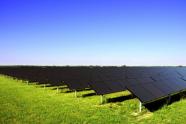Solar Off to a Good Year
New Projects to get Sited, Funded

The solar industry is off to a good year. Not only have state and federal regulators given many proposed projects the go-ahead but federal lawmakers have also extended some critical tax breaks that make the financing of those deals possible.
Solar energy represents a bright spot on the economic front. The sustainable fuel source has enjoyed support from the venture capital community while the regulatory structure has worked to support major projects. Like all new ventures, however, it too has suffered during the downturn with some skeptics saying that many pending deals will fade.
The two latest solar enterprises to win approvals from the California Energy Commission are to be located in Southern California. The so-called Palen and Rice projects are actually the eighth and ninth "concentrated" solar thermal plants that the commission has licensed in recent months, which together will generate 650 megawatts. All the California deals that have already been approved would create 4,142 megawatts.
"These solar projects will reinvigorate our economy and bring jobs to hard-hit communities," says Energy Commission Chairwoman Karen Douglas. "As we look to harness more renewable sources of energy by 2020, California leads the nation by embracing the power of the sun."
Altogether, 49 projects that would produce 11,000 megawatts are under consideration there, says the California governor's office. That would certainly help the state meet its renewable portfolio standard set at 33 percent of all electricity sold by the regulated utilities by 2020.
To qualify for federal stimulus funds, projects had to be Okayed by the Energy Commission before 2010 ended. The most recent deals will still need permission from the Bureau of Land Management, which has jurisdiction where federal lands are to be used. The Rice project, meantime, also needs approval from the Western Area Power Administration. All are expected sometime in 2011.
To be clear, utility-scale solar facilities, often referred to as concentrated solar power, are different than rooftop solar panels that are used by residential customers. The former are best-suited in the southwestern United States where conditions are sunny and dry. But such facilities require large plots of land. Those plants are also expensive or about $1 billion to build. Commercial banks simply won't take the chance.
The bigger facilities such as those just announced by the California Energy Commission are both untested and largely unable at present to connect to transmissions systems to take the electricity from the desert to the cities. Rooftop solar panels that are used by residential and commercial customers, by comparison, are proven, less controversial and can be easily connected to existing power lines.
Blind Spots Ahead
To be sure, some blind spots are ahead, particularly for the bigger and more expensive plants that require heavy financing. Even those utility-scale facilities are coming under fire from some environmental organizations that say their large footprints are disturbing the natural habitat in the southwestern desert land where they would be located.
"Over the next few years, we'll see half of the utility-scale solar mega wattage currently on the drawing board go by the wayside because of financing challenges," says Edwin Feo, managing partner at USRG Renewable Finance in Los Angeles.
Given the recent moves by Congress as well as the U.S. Department of Interior, however, the solar industry has reason to smile. A program created under the federal stimulus plan enacted in early 2009 provides commercial solar installations with a cash grant in lieu of the 30 percent solar investment tax credit. That's because such companies have had difficulty getting the capital to start projects much less to take advantage of tax credits after those ventures had revved up.
The cash grant has helped more than 1,100 solar projects of all types move forward in 42 states, says the Solar Industries Energy Association. That equates to $18 billion in investment, which has allowed the industry to expand more than 100 percent in 2010 and provide energy to 200,000 homes in this country.
At about the same time, the Interior Department said it would expedite the permitting process on public lands. It has released a draft identifying 24 solar energy zones in Arizona, California, Colorado, Nevada, New Mexico and Utah that it says have the most utility-scale solar potential - but which would cause the least environmental impact.
All told, an additional 22 million acres will be open to potential solar development - in a move that the administration says could spur 24,000 megawatts of megawatts of solar power down the road. To get started, Interior Department has fast-tracked 14 projects.
Among those just Okayed is the Amargosa Farm Solar Project to be built by Solar Millennium and which is to be located near Las Vegas. The 500-megawatt facility, which will be eligible to receive $1 billion in tax credits, will use parabolic-shaped mirrors to focus the sun's energy so as to generate steam and turn turbines to produce power.
"For years, the oil and gas industries have had an easy path for getting permits to drill on public lands," says Rhone Resch, chief executive of the solar group. "Solar energy projects are now closer to a more predictable review and approval process for projects on public land."
Favorable government policies to ease the permitting process and to provide start up capital are helping. But after the recession subsides and the solar industry matures, companies will need to prove themselves in the market - a task that the solar sector says is doable and one in which it is willingly embracing.
EnergyBiz Insider has been named Honorable Mention for Best Online Column by Media Industry News, MIN.
So what do you think? Please share your thoughts by posting a quick comment below, or by sending a longer reply to energybizinsider@energycentral.com.
Follow Ken on www.twitter.com/freehand1200